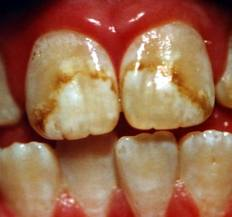Food For Thought Column from Consumer Research Magazine
February 1983
By Beatrice Trum Hunter
Question: Can you give me information about fluorine and fluoride in foods?
Answer: Fluorine is one of over a hundred elements that have been identified to date. Fluorine is found naturally in many foods, with high amounts in fish, especially mackerel, salmon and sardines, as well as gelatine, bone meal, salt pork and brewed tea. Among commonly consumed vegetables, kale, potatoes, and spinach have moderately high amounts. Root and tuber crops, especially, accumulate fluorine when phosphate fertilizer is used. Fluoride, a fluorine compound, is found at levels of 0.5 to 4.0 percent by weight as an impurity in phosphate fertilizers.
Another source of fluoride in the food supply has been found in recent times with the introduction of mechanically deboned meat, poultry, and fish. (For a discussion of this subject, see Consumers' Research magazine, Feb, 1979). For example, frankfurters, composed of up to 10 percent mechanically deboned meat, were found to contain about 1.7 milligrams of fluoride per kilogram (2.2 lb. approximately) of the meat product.
Although fluoride is introduced intentionally into many public drinking water supplies for the purpose of preventing tooth decay, increasingly fluoride is entering the food supply unintentionally, indirectly, and in an uncontrolled manner. Three major sources are: 1) the use of water for food processing in plants located in communities where the water is fluoridated, 2) the increased use of commercially prepared infant feeding formulas and baby food products which contain fluorides, and 3) the ingestion, especially by young children, of toothpastes and tooth powders containing fluoride.
Severe fluoride poisoning
White spots of mild fluoride poisoning
Researchers have found various concentrations of fluorides in commercial infant feeding formulas and baby foods. In many cases, the level of fluoride was related to the fluoride-treated water in the community where the product was manufactured. Both concentrated and ready-to-serve-type milk-based baby food formulas have been analyzed for their fluoride content. The amounts ranged from 0.58 to 0.67 milligrams (mg) per liter (1.06 qt.) in products processed in communities with fluoridated water, contrasted with levels only up to 0.15 mg per liter in places where the water supply was not fluoridated.
The fluoride intake from typical diets of infants from two to six months of age was estimated to average about 0.1 mg. per kilogram of body weight from foods processed in communities with fluoridated water. Fluorosis (fluoride poisoning) can develope from a daily fluoirde intake as low as 0.1 mg. per kilogram of body weight up to the age of twelve, which suggests that safe flouride intake assumed to be safe may be exceeded for many infants. Parents shopping for the baby feeding products have no way of knowing whether the product they buy has been processed in fluoridated or nonfluoridated communities, nor the level of fluoride present.
Food intake of the two year olds was estimated to be within a more acceptable range for safe daily intake of fluoride. The fluoride level in dry cereal products intended for babies also strongly matched the fluoride level of the water in the community where the product was processed. A high fluoride content in baby food products such as strained chicken may be related to the presence of bone chips in these products. The fluoride content of ready-to-drink fruit juices intended for babies was found to have been increased by 5 to 20 times when fluoridated water had been used in the processing of the juices.
Skeletal fluorosis
Beverages, soups, canned fruits and vegetables, and other foods prepared with water and consumed by all age groups, may also show high levels of fluoride, depending on the locations of the processing plants.
Nearly all dentrifices sold in North America, Europe, Australia and New Zealand are fluoridated. To some extent, all dentrifice users unknowingly ingest some of the product as they brush their teeth.
It was reported that nearly half of all children in Great Britain begin brushing their own teeth by the age of 12 months; three fourths of all children, by 18 months. It is likely that the British finding is typical for other countries where dentrifices are used. How much dentrifice children under two years of age ingest is unknown, but it has been reported that, of all age groups, children under five years of age ingest the most.
The presence of fluorides from unintentional and uncontrolled sources in the food supply, not only for infants and young children but for the entire population, is a growing fact that can no longer be ignored. Food sources increasingly contribute a significant amount to the total intake of intentional fluorides in treated water, as well as unintentional sources of fluorides from environmental pollution. It is quite possible that the total intake of fluorides from all sources may now be higher for many individuals than is considered to be a safe level.
Beatrice Trum Hunter is the author of a number of books concerning food topics of importance to consumers. The most recent ones include The Great Nutrition Robbery, The Mirage of Safety, and The Sugar Trap and How to Avoid It. Hunter is a frequent guest lecturer at universities and at meetings of health professionals, and from time to time, she appears on national commercial and public television programs.






Is there any advancement being made to get rid of fluoride?
ReplyDeleteAre you referring to external sources of fluoride, such as the water supply or do you mean detoxing it from the body? I can ask the author if you want to specify
ReplyDeleteI just found your web site. What a novel idea...taking control of our health.
ReplyDelete